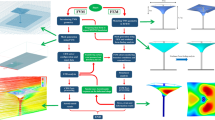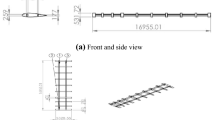The aeroelastic instability is the mutual interaction of aerodynamic, structural, and inertial forces that can cause the flutter in aircraft structures. In this research, applying the coupling of a flutter with two degrees of freedom and the finite-element method, to a symmetric airfoil section of an aircraft tail, the flutter speed is investigated. The geometry and thickness of tail skin and isotropic and layups of composite materials are effective parameters of the torsional and bending stiffnesses of the airfoil section studied using the finite-element method. Lagrange’s equation is used to analyze the aeroelastic instability of the tail. Finally, the impact of the effective parameters on the flutter speed and instability of tail are discussed. The results obtained show that, at the same thickness, the flutter speed of angle-ply layups is higher than of quasi-isotropic composite laminates.








Similar content being viewed by others
References
P. Omenzetter, K. Wild, and Y. Fujino, “Suppression of wind-induced instabilities of a long span bridge by a passive deck–flaps control system,” Part I: Formulation, J. Wind Eng. Industrial Aerodynamics, 87, No. 1, 61-79 (2000).
F. Mastroddi, M. Tozzi, and V. Capannolo, “On the use of geometry design variables in the MDO analysis of wing structures with aeroelastic constraints on stability and response,” Aerospace Sci. Technol., 15, No. 3, 196-206 (2011).
J. K. S. Dillinger, T. Klimmek, M. M. Abdalla, and Z. Gürdal, “Stiffness optimization of composite wings with aeroelastic constraints,” J. Aircraft, 50, No. 4, 1159-1168 (2013).
O. Stodieck, J. E. Cooper, P. M. Weaver, and P. Kealy, “Aeroelastic tailoring of a representative wing box using tow-steered composites,” AIAA J., 55, No. 4, 1425-1439 (2017).
N. Babouskos and J. T. Katsikadelis, “Flutter instability of damped plates under combined conservative and non-conservative loads,” Archive of Appl, Mech., 79, No. 6, 541-556 (2009).
Z. Li, B. Wen, X. Dong, Z. Peng, Y. Qu, and W. Zhang, “Aerodynamic and aeroelastic characteristics of flexible wind turbine blades under periodic unsteady inflows,” J. Wind Eng. Industrial Aerodynamics, 197, 104057 (2020).
A. R. Ghasemi, A. Jahanshir, and M. H. Tarighat, “Numerical and analytical study of aeroelastic characteristics of wind turbine composite blades,” Wind and Structures, 18, No. 2, 103-116 (2014).
A. R. Ghasemi and M. Mohandes, “Composite Blades Of Wind Turbine: Design, Stress Analysis, Aeroelasticity, and Fatigue,” in: Wind Turbines-Design, Control And Applications, InTechOpen, 2016. 1-26.
S. P. Evans, D. R. Bradney, and P. D. Clausen, “Development and experimental verification of a 5 kW small wind turbine aeroelastic model,” J. Wind Eng. Industrial Aerodynamics, 181, 104-111 (2018).
C. Saxton and F. F. Afagh, “Modelling and dynamic stability of a hingeless active fibre composite blade.” Archive of Appl, Mech., 80, No. 8, 843-868 (2010).
M. T. Piovan, S. Domini, and J. M. Ramirez, “In-plane and out-of-plane dynamics and buckling of functionally graded circular curved beams,” Composite Structures, 94, No. 11, 3194-3206 (2012).
D. H. Hodges, “Non-linear in-plane deformation and buckling of rings and high arches,” Int. J. Non-Linear Mech., 34, No. 4, 723-737 (1999).
O. O. Ozgumus and M. O. Kaya, “Energy expressions and free vibration analysis of a rotating Timoshenko beam featuring bending–bending-torsion coupling,” Archive of Appl, Mech., 83, No. 1, 97-108 (2013).
M. R. Amoozgar and H. Shahverdi, “Aeroelastic stability analysis of curved composite blades in hover using fully intrinsic equations,” Int. J. Aeronautical and Space Sciences, 20, No. 3, 653-663 (2019).
M. R. Amoozgar, S. A. Fazelzadeh, H. H. Khodaparast, M. I. Friswell, and J. E. Cooper, “Aeroelastic stability analysis of aircraft wings with initial curvature,” Aerospace Sci. Technol., 107, 106241 (2020).
A. Elham and M. J. van Tooren, “Winglet multi-objective shape optimization,” Aerospace Sci. Technol., 37, 93-109 (2014).
M. Ghalandari, S. Shamshirband, A. Mosavi, and K. W. Chau, “Flutter speed estimation using presented differential quadrature method formulation,” Eng. Applications of Computational Fluid Mech., 13, No. 1, 804-810 (2019).
L. H. van Zyl and E. H. Mathews, “Aeroelastic analysis of T-tails using an enhanced Doublet Lattice Method,” J. Aircraft, 48, No. 3, 823-831 (2011).
A. Attorni, L. Cavagna, and G. Quaranta, “Aircraft T-tail flutter predictions using computational fluid dynamics,” J. Fluids and Structures, 27, No. 2, 161-174 (2011).
N. Nguyen-Thanh, K. Zhou, X. Zhuang, P. Areias, H. Nguyen-Xuan, Y. Bazilevs, and T. Rabczuk, “Isogeometric analysis of large-deformation thin shells using RHT-splines for multiple-patch coupling,” J. Computer Methods Appl. Mech. Eng., 316, 1157-1178 (2017).
N. Valizadeh, S. Natarajan, O. A. Gonzalez-Estrada, T. Rabczuk, T. Q. Bui, and S. P. A. Bordas, “NURBS-based finite element analysis of functionally graded plates: Static bending, vibration, buckling and flutter, “ J. Compos. Struct., 99, 309-326 (2013).
T. T. Truong, J. Lee, and T. Nguyen-Thoi, “Multi-objective optimization of multi-directional functionally graded beams using an effective deep feedforward neural network-SMPSO algorithm,” Structural and Multidisciplinary Optimization, 63, Iss. 6, 2889-2918 (2021).
H. Guo, X. Zhuang, and T. Rabczuk, “A Deep Collocation Method for the Bending Analysis of Kirchhoff Plate,” Tech Science Press, 59, No. 2, 433-456 (2019).
X. Zhuang, H. Guo, N. Alajlan, H. Zhu, and T. Rabczuk, “Deep autoencoder based energy method for the bending, vibration, and buckling analysis of Kirchhoff plates with transfer learning,” Eur. J. Mech. - A/Solids, 87, Article 104225 (2021).
J. Murua, P. Martínez, H. Climent, L. van Zyl, and R. Palacios, “T-tail flutter: Potential-flow modelling, experimental validation and flight tests,” Progress in Aerospace Sciences, 71, 54-84 (2014).
D. Tang and E. H. Dowell, “Computational/experimental aeroelastic study for a horizontal-tail model with free play,” AIAA Journal, 51, No. 2, 341-352 (2013).
F. Afonso, J. Vale, É. Oliveira, F. Lau, and A. Suleman, “A review on non-linear aeroelasticity of high aspect-ratio wings,” Progress in Aerospace Sciences, 89, 40-57 (2017).
A. Hermanutz and M. Hornung, “Aeroelastic wing planform design optimization of a flutter UAV demonstrator,” Aerospace, 7, No. 4, 45 (2020).
S. Kumar, A. K. Onkar, and M. Manjuprasad, “Stochastic modeling and reliability analysis of wing flutter,” J. Aerospace Eng., 33, No. 5, 04020044 (2020).
D. H. Hodges and G. A. Pierce, Introduction to Structural Dynamics and Aeroelasticity, 15, Cambridge University press (2011).
R. Aleksandrowicz and W. Lucjanek, Sailplane Stiffness Measurements, 5, OSTIV Publications (1958).
B. Budiansky, J. N. Kotanchik, and P. T. Chiarito, “A Torsional Stiffness Criterion for Preventing Flutter of Wings of Supersonic Missiles,” National Advisory Committee For Aeronautics Langley Field VA Langley Aeronautical Laboratory (1947).
Author information
Authors and Affiliations
Corresponding author
Rights and permissions
Springer Nature or its licensor (e.g. a society or other partner) holds exclusive rights to this article under a publishing agreement with the author(s) or other rightsholder(s); author self-archiving of the accepted manuscript version of this article is solely governed by the terms of such publishing agreement and applicable law.
About this article
Cite this article
Nejatbakhsh, H., Ghasemi, A.R., Gharaei, A. et al. An Analytical-Numerical Coupled Model for an Aeroelastic Analysis of Tail Flutter Based on Bending–Torsional Coupling. Mech Compos Mater 59, 757–768 (2023). https://doi.org/10.1007/s11029-023-10129-3
Received:
Published:
Issue Date:
DOI: https://doi.org/10.1007/s11029-023-10129-3




